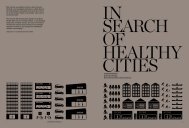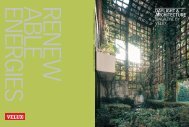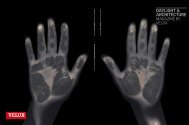Download as PDF - Daylight & Architecture - Magazine by | VELUX
Download as PDF - Daylight & Architecture - Magazine by | VELUX
Download as PDF - Daylight & Architecture - Magazine by | VELUX
You also want an ePaper? Increase the reach of your titles
YUMPU automatically turns print PDFs into web optimized ePapers that Google loves.
Even in introverted buildings,daylight can establish an importantlink to nature. Its variabilityand continuous changes havea positive connotation in humanperception and are very difficultto emulate with artificial light.shafts in deeper spaces, and integratinggreater exposure to daylight, particularlyin dwelling/living spaces to significantlyincre<strong>as</strong>e levels of daylight.A FUTURE VISION<strong>Architecture</strong>’s connectedness to lighth<strong>as</strong> always been both physical and aesthetic.Architects have used daylight toaccentuate and focus on the articulationof architectural language, or to dematerialisethe building elements to counteractmateriality and promote spatiality, <strong>as</strong> apoetic intersection between place andspace making. 5Modern architecture h<strong>as</strong> been preoccupiedwith capturing the physical propertiesof daylight and liberating light andspace. Using gl<strong>as</strong>s <strong>as</strong> the b<strong>as</strong>ic buildingmaterial, the architects of Modernismaddressed the notion of connectedness.This can be seen in works such <strong>as</strong> BrunoTaut’s Gl<strong>as</strong>s pavilion at the Werkbund exhibitionin Cologne (1914), Mies van derRohe’s Tugendhat House in Brno (1928),his German Pavilion in Barcelona (1929)and Pierre Chareau’s Maison de Verre inParis (1931). Other well-known examplesare Le Corbusier’s Villa Savoye in Poissy(1931) and Mies van der Rohe’s FarnsworthHouse in Illinois (1946). These architectssuccessfully explored daylight interms of reflections, transparency, translucencyand luminosity, and worked empiricallytowards a ‘dematerialisation’ ofarchitecture to reach a sublime space.In the second half of the twentieth century,a range of internationally acclaimedarchitects such <strong>as</strong> Rafael Moneo, Toyo Ito,Stephen Holl, Peter Zumthor, Herzog &de Meuron, Erick van Egeraat, SANAAand John Pawson extended this preoccupationwith dematerialising space <strong>by</strong>focusing on the phenomenology experienceof daylight itself, seeking to capturea metaphysical response to architecture.So far, architects’ concern for daylighth<strong>as</strong> been driven <strong>by</strong> a need to control theindoor climate, to maintain comfort, andto penetrate the shell of the interior spaceto admit light. The primary interface andfilter for daylight, h<strong>as</strong> been the window.Gl<strong>as</strong>s permitted the window to fuse intothe architectonic form, to provide enclosure,to control indoor temperature andto transmit and celebrate the qualitiesand benefits of daylight. Gl<strong>as</strong>s h<strong>as</strong> alsobeen the me<strong>as</strong>ure of how individual architectshave related their architecturalvision to the well-being and comfort ofusers and inhabitants.In contemporary terms, the windowshave now become the building, and gl<strong>as</strong>sthe interface for future engagementbetween daylight and living, betweenthe physical and the psychological, betweencomfort and well-being. Buildingon the legacy of Frank Lloyd Wright andMies van der Rohe to present day PeterZumthor, we are now seeing a new eraof humane and sustainable architecture.This era speaks of the architect <strong>as</strong> a professionalpolymath, capable of embracingcomplexity and change; and <strong>as</strong> a humanitarianwho is concerned with the value ofdaylight <strong>as</strong> a life-giving substance.We now need to initiate advancedresearch into a new field that we mightcall the ‘anthropology of daylight’, or the‘culture of transparency’ in all buildings,and to seize the opportunity to enjoy agreater sense of well-being. But in doingso, we must also recognise that this t<strong>as</strong>kcannot be left to architects alone. We needteams of specialists to contribute andexpand our knowledge and develop newmethodologies and carry out live ratherthan laboratory experiments. It is timeto conceive of buildings that totally embracedaylight for its power and energy,for its visual delight and beauty, and forits healthy environmental effects.After all, daylight is freely available and,<strong>as</strong> far <strong>as</strong> we can judge, timeless, and theonly truly sustainable way to live in thefuture.Brent Richards is an architect, designer, academic,and polymath. He is currently CEO of TheDesign Emb<strong>as</strong>sy Europe, a transdisciplinary creativeconsultancy in London that focuses onarchitecture, spatial design and experiential environments.Brent is also Principal – Europe & Scandinavia,of Transpolis Global – Urban Designers andArchitects. He h<strong>as</strong> conducted pioneering work onthe advanced use of gl<strong>as</strong>s technology, for which hew<strong>as</strong> awarded the International Benedictus Award(USA) in 1995 <strong>by</strong> Du Pont and the American Instituteof Architects (AIA).References1. Alexander, C. (1979): ‘The Timeless Way of Building’,Oxford University Press – ‘Patterns which arealive’ (p. 111)2. Heerwagen, J.H. (1990): ‘Affective Functioning,Light Hunger and Room Brightness Preferences’. In:Environment and Behavior, 22 (5), p. 608-6353. Turrell, J. (2009): ‘Geometry of Light‘, HatjeCantz Verlag (p. 21)4. Foster, R.G. (2011): ‘Body Clocks, Light, Sleep andHeath’, in: Circadian and Visual Neuroscience5. Richards, B. (2006): ‘Space Light and Transformation– Gl<strong>as</strong>s <strong>Architecture</strong> for the 21st Century’Laurence King Publishers51










